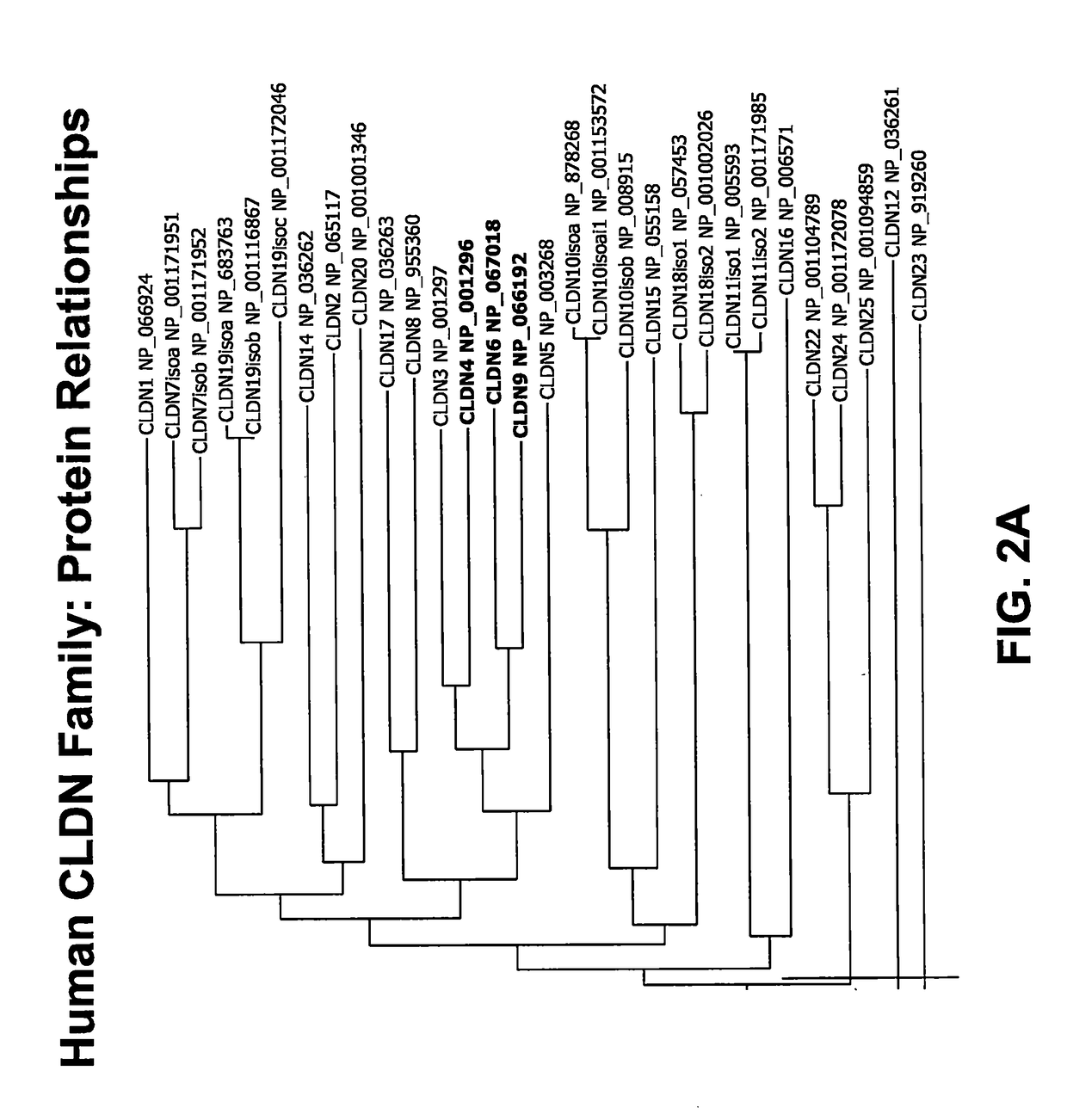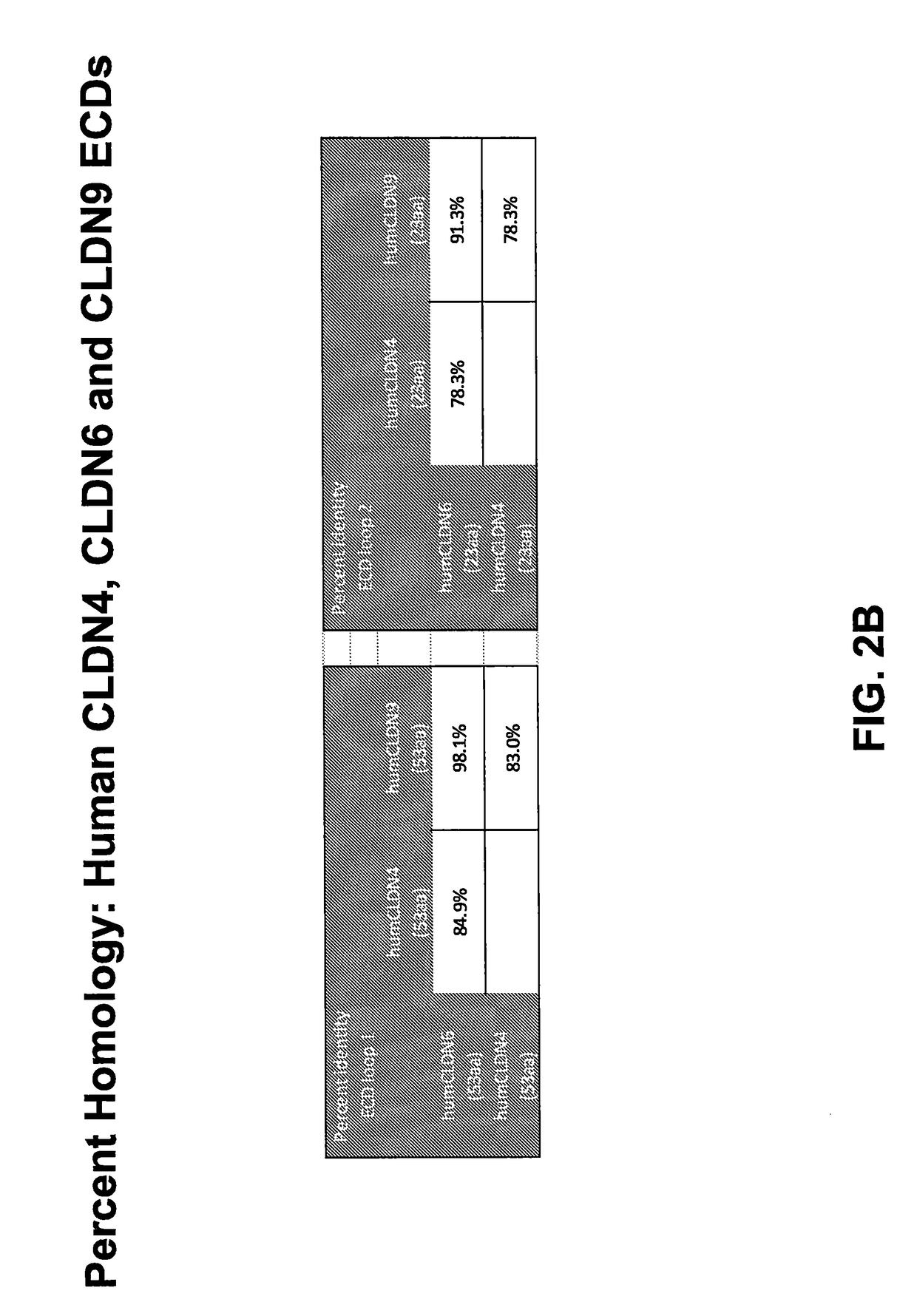Anti-cldn chimeric antigen receptors and methods of use
a technology of chimeric antigen receptors and anti-cldn, applied in the field of adoptive immunotherapy, can solve the problems of ineffective treatment, inability to provide a viable clinical alternative, and inability to induce tumors, so as to reduce the frequency of tumor initiating cells and reduce tumor initiating cells
- Summary
- Abstract
- Description
- Claims
- Application Information
AI Technical Summary
Benefits of technology
Problems solved by technology
Method used
Image
Examples
example 1
Identification of CLDN4, CLDN6 and CLDN9 Expression on Tumors
[0279]To characterize the cellular heterogeneity of solid tumors as they exist in cancer patients, aid in the identification of CSCs using particular phenotypic markers and identify clinically relevant therapeutic targets, a large PDX tumor bank was developed and maintained using art recognized techniques. The PDX tumor bank, comprising a large number of discrete tumor cell lines, was propagated in immunocompromised mice through multiple passages of heterogeneous tumor cells originally obtained from numerous cancer patients afflicted by a variety of solid tumor malignancies. The continued availability of a large number of discrete early passage PDX tumor cell lines having well defined lineages greatly facilitates the identification and isolation of CSCs as the PDX tumors allow for the reproducible and repeated characterization of CSCs. The use of minimally passaged PDX tumor cell lines simplifies in vivo experimentation an...
example 2
Cloning and Expression of Recombinant CLDN Proteins
[0284]In order to deduce the relationship between claudin protein sequences, the AlignX program of the Vector NTI software package was used to align 30 claudin protein sequences from 23 human CLDN genes. The results of this alignment are depicted as a dendrogram in FIG. 2A. A review of the figure shows that CLDN6 and CLDN9 are very closely related in sequence, appearing adjacent to one another on the same branch of the dendrogram. FIG. 2A also shows that CLDN4 is the next most closely related family member to CLDN6. A more detailed review of the data shows that the human CLDN6 protein is very closely related to the human CLDN9 protein sequence in the extracellular domains (ECD), with >98% identity in ECD1 and >91% identity in ECD2 (FIG. 2B). Human CLDN4 was also found to be closely related to human CLDN6 in the ECD sequences, with >84% identity in ECD1 and >78% identity in ECD2 (FIG. 2B). Based upon these protein sequence relationsh...
example 3
Generation of Anti-CLDN Antibodies
[0294]Because CLDN6 is most homologous to CLDN4 and CLDN9 (see FIG. 2A and analysis as described in Example 2, above), CLDN6 was used as the immunogen with which to generate multireactive anti-CLDN antibodies. Mice were inoculated with HEK-293T cells or 3T3 cells overexpressing hCLDN6 (generated as described in Example 2) in order to produce antibody-generating hybridomas. Six mice (two each of the following strains: Balb / c, CD-1, FVB) were inoculated with 1 million hCLDN6-HEK-293T cells emulsified with an equal volume of TiterMax® adjuvant. A second, separate inoculation of six mice (two each of the following strains: Balb / c, CD-1, FVB) was performed using 3T3 cells overexpressing CLDN6. Following the initial inoculation the mice were injected twice weekly for 4 weeks with cells overexpressing CLDN6 emulsified with an equal volume of alum adjuvant.
[0295]Mice were sacrificed and draining lymph nodes (popliteal, inguinal, and medial iliac) were disse...
PUM
| Property | Measurement | Unit |
|---|---|---|
| dissociation constant | aaaaa | aaaaa |
| dissociation constant | aaaaa | aaaaa |
| dissociation constant | aaaaa | aaaaa |
Abstract
Description
Claims
Application Information
 Login to View More
Login to View More - R&D
- Intellectual Property
- Life Sciences
- Materials
- Tech Scout
- Unparalleled Data Quality
- Higher Quality Content
- 60% Fewer Hallucinations
Browse by: Latest US Patents, China's latest patents, Technical Efficacy Thesaurus, Application Domain, Technology Topic, Popular Technical Reports.
© 2025 PatSnap. All rights reserved.Legal|Privacy policy|Modern Slavery Act Transparency Statement|Sitemap|About US| Contact US: help@patsnap.com



